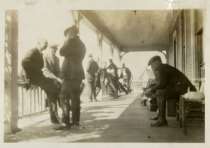
Confederates operated the mine from 1861-1863, when Union armies invaded, captured Cleveland and shut down the mining operation.
Capitalized in 1860, Burra Burra Copper Company (named for a well known Australian mine) consolidated three existing mining operations with an initial capital stock of $1.5 million. Company officers were William H. Peet, president; George O. Sweet, secretary; William H. Peet, John Thomas, E. MacPherson (who later served as president), and Lyman W. Gilbert, directors. The company controlled 5,000 acres, mostly around Turtletown. The board of directors named Julius E. Raht, a young German engineer residing in Ducktown, as superintendent of the Polk County operations. Raht was also granted a concession to run the mining commissary, an arrangement that made him rich? In 1861, the Confederacy took over the mining operation, which had previously sold most of its output to northern refineries. Many of the miners left to fight in the war, and the mines operated at a reduced capacity thereafter. Copper ore was brought to the surface, smelted, and then moved by road to Cleveland, Tennessee, to a refinery. From Cleveland, the refined ore was transported by rail to southern manufacturers to be shaped into percussion caps and other implements of war. In 1863, Union armies invaded east Tennessee, captured Cleveland and it's refinery and shut down the mining operation in Ducktown. Julius Raht left in 1864 to take refuge in Cincinnati, returning in 1866 to resume oversight of the mines. He died in 1879 and is buried in Fort Hill Cemetery in Cleveland. The Burra Burra Company collapsed in 1875. By 1900, mining operations, harvesting of forests to fuel the smelters, and emissions from the smelters had combined to denude approximatelt 32,000 acres around Ducktown, creating a virtual moonscape. The ecological devastation of the area after copper was discovered there in 1843 led to the Copper Basin's being considered the largest man-made biological desert in the country and also brought about the first study on the long-term effects of acid rain. Today, the process has been partially reversed through ongoing soil reclamation efforts, though the effects are still visible. The Burra Burra Copper Mine is on the National Register of Historic Places.
Tools
Key Facts
- Burra Burra operated 5,000 acres, mining and smelting ore, shipping it to a Cleveland refinery
- Confederate troops operated it at a reduced capacity until Union troops shut it down
- Environmental effects of the mining are still visible today


